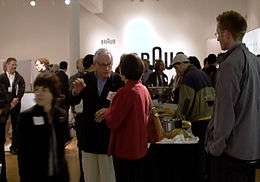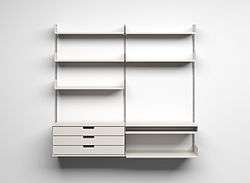Dieter Rams
| Dieter Rams | |
|---|---|
 Dieter Rams at Vitsœ | |
| Born |
20 May 1932 Wiesbaden, Hessen, Germany |
| Nationality | German |
| Occupation | Industrial Designer |
| Known for | Braun consumer products, Vitsœ 606 Universal Shelving System |

H.C. Dieter Rams (born 20 May 1932 in Wiesbaden, Hessen) is a German industrial designer and retired academic[1] closely associated with the consumer products company Braun and the Functionalist school of industrial design. His unobtrusive approach and belief in "less but better" design generated a timeless quality in his products and have influenced the design of many products, which also secured Rams worldwide recognition and appreciation.
Life and career
Dieter Rams began his studies in architecture and interior decoration at Wiesbaden School of Art in 1947. A year later, in 1948, he took a break from studying to gain practical experience and finish his carpentry apprenticeship. He returned to Wiesbaden School of Art in 1948 and graduated with honours in 1953 after which he began working for Frankfurt-based architect Otto Apel. In 1955, he was recruited to Braun as an architect and an interior designer. In 1961, he became the Chief Design Officer at Braun, a position he retained until 1995.[2]
Dieter Rams was strongly influenced by the presence of his grandfather, a carpenter. Rams once explained his design approach in the phrase "Weniger, aber besser" which translates as "Less, but better". Rams and his staff designed many memorable products for Braun including the famous SK-4 record player and the high-quality 'D'-series (D45, D46) of 35 mm film slide projectors. He is also known for designing a furniture collection for Vitsœ in the 1960s including the 606 Universal Shelving System and 620 Chair Programme.
By producing electronic gadgets that were remarkable in their austere aesthetic and user friendliness, Rams made Braun a household name in the 1950s.
In 2010, to mark his contribution to the world of design, he was awarded the 'Kölner Klopfer' prize by the students of the Cologne International School of Design and in 2009 awarded the great design prize in Australia. In addition, as successor to the Bauhaus, Rams eventually became a protégé of the Ulm School of Design in Ulm, Germany.[3]
Dieter Rams: ten principles for good design
Rams introduced the idea of sustainable development and of obsolescence being a crime in design in the 1970s.[2] Accordingly, he asked himself the question: is my design good design? The answer formed is now the celebrated ten principles.
Good design:[4]
- is innovative – The possibilities for progression are not, by any means, exhausted. Technological development is always offering new opportunities for original designs. But imaginative design always develops in tandem with improving technology, and can never be an end in itself.
- makes a product useful – A product is bought to be used. It has to satisfy not only functional, but also psychological and aesthetic criteria. Good design emphasizes the usefulness of a product whilst disregarding anything that could detract from it.
- is aesthetic – The aesthetic quality of a product is integral to its usefulness because products are used every day and have an effect on people and their well-being. Only well-executed objects can be beautiful.
- makes a product understandable – It clarifies the product’s structure. Better still, it can make the product clearly express its function by making use of the user's intuition. At best, it is self-explanatory.
- is unobtrusive – Products fulfilling a purpose are like tools. They are neither decorative objects nor works of art. Their design should therefore be both neutral and restrained, to leave room for the user's self-expression.
- is honest – It does not make a product appear more innovative, powerful or valuable than it really is. It does not attempt to manipulate the consumer with promises that cannot be kept.
- is long-lasting – It avoids being fashionable and therefore never appears antiquated. Unlike fashionable design, it lasts many years – even in today's throwaway society.
- is thorough down to the last detail – Nothing must be arbitrary or left to chance. Care and accuracy in the design process show respect towards the consumer.
- is environmentally friendly – Design makes an important contribution to the preservation of the environment. It conserves resources and minimizes physical and visual pollution throughout the lifecycle of the product.
- is as little design as possible – Less, but better – because it concentrates on the essential aspects, and the products are not burdened with non-essentials. Back to purity, back to simplicity.
Notable awards and accomplishments
Dieter Rams has been involved in design for seven decades. This is a list of notable awards and accomplishments.[5]
- 1960 Receives ‘Kulturkreis im Bundesverband der Deutschen Industrie’ Scholarship Award
- 1961 TP1 Portable record player and radio receives ‘Supreme Award’ at Interplas exhibition, London
- 1963 F21 receives ‘Supreme Award’ at Interplas exhibition, London
- 1968 Awarded ‘Honorary Royal Designer for Industry’ of the Royal Society of Arts, UK for ‘distinguished design in furniture and light engineering products’
- 1969 620 Chair awarded ‘Gold Medal’ at the International Furniture Exhibition in Vienna
- 1978 Awarded ‘SIAD Medal of the Society of Industrial Artists and Designers’, UK
- 1985 Awarded ‘Académico de Honor Extranjero’ by the Academia Mexicana de Diseño, Mexico
- 1989 First recipient of the ‘Industrie Forum Design Hannover’, Germany, for special contribution to design
- 1989 Awarded ‘Doctor honoris causa’ by Royal College of Arts, London, UK
- 1992 Receives IKEA prize and uses prize money for his own ‘Dieter and Ingeborg Rams Foundation’ for the promotion of design
- 1996 Receives ‘World Design Medal’ from the Industrial Designers Society of America
- 2002 Awarded ‘Verdienstkreuz des Verdienstordens der Bundesrepublik Deutschland (Commanders Cross of the Order of Merit of the Federal Republic of Germany)
- 2003 Receives ‘Design Award ONDI’, Havana, Cuba for his special contribution to industrial design and world culture
- 2007 Awarded Design Prize of the Federal republic of Germany for his life’s work
- 2007 Receives Lucky Strike Designer Award from the Raymond Loewy Foundation
- 2013 Awarded Lifetime Achievement Medal at London Design Festival 2013
Less and More exhibition
Less and More is an exhibition of Rams' landmark designs for Braun and Vitsœ. It first traveled to Japan in 2008 and 2009,[6] appearing at the Suntory Museum in Osaka and the Fuchu Art Museum in Tokyo. Between November 2009 and March 2010 it appeared at the Design Museum in London.[7][8] It appeared at the Museum für Angewandte Kunst in Frankfurt from July to September 2010.[9][10] The exhibit then appeared at the San Francisco Museum of Modern Art from August 2011 to February 2012.[11]
Documentary Rams
On June 22, 2016 filmmaker Gary Hustwit announced his Kickstarter project RAMS: The First Feature Documentary About Dieter Rams. The project contains the making of a full-length documentary which will feature in-depth conversations with Rams, his (design) philosophy, his process behind some of his most iconic designs, his inspiration and his regrets, but also helps to preserve Rams' design archive in cooperation with the 'Dieter and Ingeborg Rams Foundation'.[12]
Legacy
The appearance of the calculator application included in Apple's iOS 3 mimics the appearance of the 1987 Braun ET 66 calculator[13] designed by Rams and Dietrich Lubs, and the appearance of the now playing screen in Apple's own Podcast app used to mimic the appearance of the Braun TG 60 reel-to-reel tape recorder, before a later redesign of the app removed it. The iOS 7 world clock app closely mirrors Braun's clock (and watch) design down to the font and layout used. In Gary Hustwit's 2009 documentary film Objectified, Rams states that Apple Inc. is one of the few companies designing products according to his principles.[14][15]
Examples of Dieter Rams' works
 606 Universal Shelving System, 1960
606 Universal Shelving System, 1960 Braun Dieter Rams Lighter
Braun Dieter Rams Lighter SK 61[16]
SK 61[16] Tonarmwaage, 1962
Tonarmwaage, 1962 T 1000, 1963
T 1000, 1963
T 1000 CD, 1968 audio 310, 1971
audio 310, 1971 Calculator Braun ET66, 1987
Calculator Braun ET66, 1987 Receiver (Steuergerät) Braun Regie 510, 1972
Receiver (Steuergerät) Braun Regie 510, 1972
References
- ↑ "Prof. em. Dr. h.c. Dieter Rams". Red dot. Retrieved 2016-12-06.
- 1 2 "Vitsœ | Dieter Rams". Vitsoe.com. Retrieved 2012-10-11.
- ↑ "Dieter Rams Industrial designer". Vitsoe.com. Retrieved 11 February 2013.
- ↑ "SFMOMA Presents Less and More: The Design Ethos of Dieter Rams". Sfmoma.org. Retrieved 2012-08-26.
- ↑ "Vitsœ | History". Vitsoe.com. Retrieved 2012-08-26.
- ↑ "Less and More: the design ethos of Dieter Rams in Japan". Vitsoe.com. 2008-09-15. Retrieved 2010-06-30.
- ↑ "'Less and More' at London's Design Museum". Vitsoe.com. 2009-12-04. Retrieved 2010-06-30.
- ↑ "Less and More – The Design Ethos of Dieter Rams". Designmuseum.org. 2009-11-18. Retrieved 2010-06-30.
- ↑ "Less and More in Frankfurt". Vitsoe.com. 2010-04-19. Retrieved 2010-06-30.
- ↑ "Less and More – Das Designethos von Dieter Rams [requires Flash". Angewandtekunst-frankfurt.de. Retrieved 2010-06-30.
- ↑ "'Less and More': The Design Ethos of Dieter Rams". SFMoMa.com. 2011-08-27. Retrieved 2011-09-04.
- ↑ "RAMS: The First Feature Documentary About Dieter Rams". kickstarter.com. 2016-06-22. Retrieved 2016-12-06.
- ↑ "Apple design and Dieter Rams". mac-history.net. Retrieved 14 April 2013.
- ↑ "Design evolution". Braun GmbH. 2009. Retrieved 24 May 2011.
Designer: Dieter Rams and Dietrich Lubs
- ↑ "The Future Of Apple Is In 1960s Braun: 1960s Braun Products Hold the Secrets to Apple's Future". gizmodo.com. Gawker Media. 14 January 2008. Retrieved 30 June 2010.
- ↑ Dieter Rams and Hans Gugelot, 1956
Further reading
- Klemp, Klaus and Ueki-Polet, Keiko (2011). Less and More: The Design Ethos of Dieter Rams. Die Gestalten Verlag. ISBN 978-3-89955-397-0
- Lovell, Sophie (2011). As Little Design As Possible: The Work of Dieter Rams. London: Phaidon. ISBN 978-0-7148-4918-8
External links
| Wikimedia Commons has media related to Dieter Rams. |
- London's Design Museum page on Dieter Rams
- Designboom page on Dieter Rams
- Icon magazine interview with Dieter Rams
- A later Icon interview
- Vitsœ on Dieter Rams